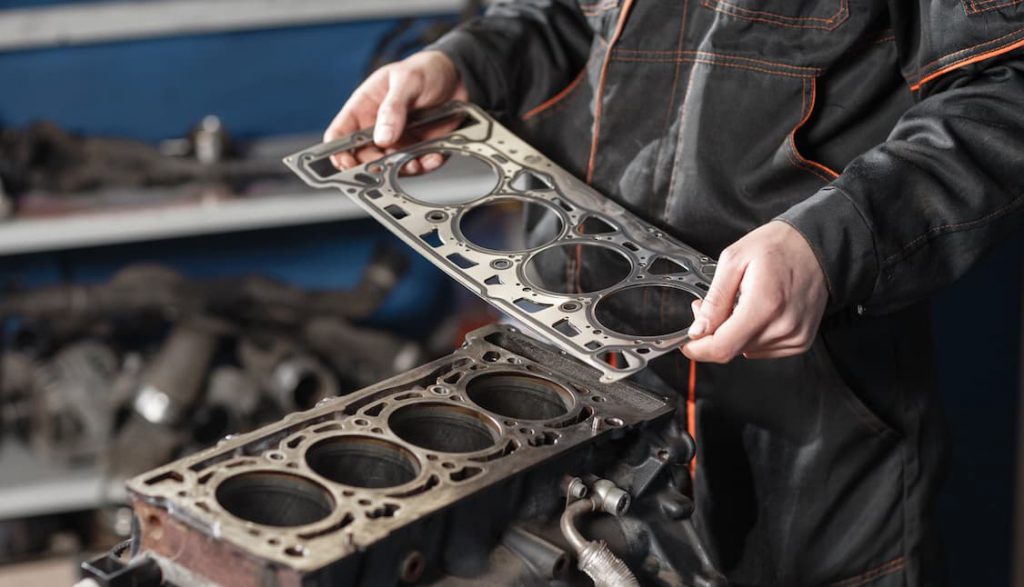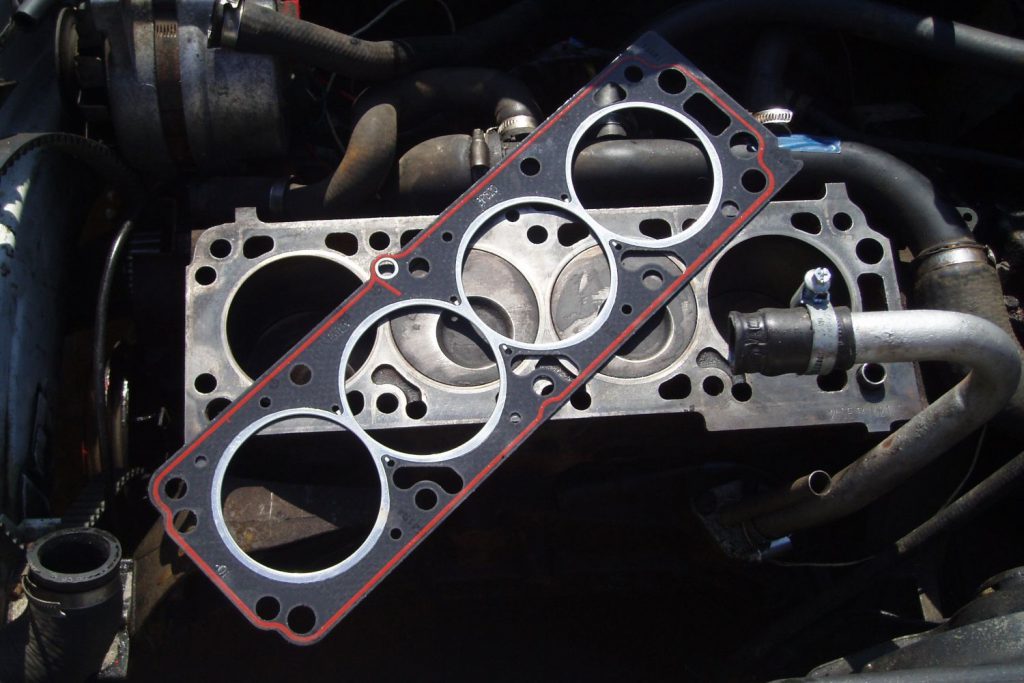Imagine you’re driving to work one day and you notice your car feels sluggish or the white smoke from the tailpipe. What’s the culprit of these issues? It’s the classic sign of a blown head gasket. And the question is how to fix a blown head gasket without replacing it. Ready to get educated!
Contents
What Are The Symptoms Of A Blown Head Gasket?
The purpose of the head gasket is to seal the combustion chamber, coolant passages, and engine oil passages. It prevents them from mixing together or leaking out of the engine. Some might say that your engine can’t really run without a head gasket so you may understand the important role of this part in your car. What would happen when the head gasket is blown? Before going deep into the warning signs, we should understand the term “blown head gasket”
A blown head gasket is when the gasket that secures the cylinder head to the engine block has failed. Coolant, oil, or combustion gases can leak out from this bad head gasket. And the consequences of this can range from a visible leak of the oil or coolant to a noticeable reduction in performance and driveability. We will explain to you 5 unmistakable symptoms of a blown head gasket:

A mixture of oil & coolant
The first symptom you could experience with your car is a mixture of oil and coolant. You’ll notice the cappuccino color on the dipstick in some situations and you can see the milk substance when removing the engine cap. This happens when the head of the gas gets torn leaking coolant into the oil passages or vice versa. Although not conclusive proof of the failure head gasket, it’s a sure sign your engine needs to come apart to find out the contamination.
Overheating engine
A faulty head gasket may have been caused by an engine overheating too many times (due to the clogged radiator, bad fan, or coolant leak) but you don’t know that a blown head gasket is also the culprit of the overheating engine too. At that time you’ll notice the temperature gauge climb up and in the worst situation, the engine will start smoking. If the head gasket is broken, the hot exhaust gas can leak into the cooling system, or the coolant can leak into the cylinders and be burned off as steam, either way, the end result is an overheating engine.
Thick white smoke
A bad head gasket most often results in large clouds of sweet-smelling white smoke coming from the tailpipe. This is caused by the antifreeze leaking past the gasket and into the cylinders where it is turned to steam as part of the combustion process. Less common but still possible, is a leak from an oil passage to the cylinder, which will cause the blueish smoke.
Loss of power (poor performance)
The fourth symptom is the notable reduction in engine power. If the head gasket fails in such a way, it allows the compressed air/fuel to escape, and the compression of that cylinder is reduced. This loss of compression results in a rough-running engine and your car will be a lot slower than usual. In some situations, you also get a check engine light with misfire codes. You can read these codes with a scanner. This sort of failure typically is accompanied by a sound like an exhaust leak.
External leaks
If a head gasket has failed between the water or oil passage and the outside of the engine, the result can be a simple coolant or an oil leak. This is the least dire version of a blown head gasket, but still serious. This may not manifest itself as an immediate problem (other than causing a mess) but if the coolant level is allowed to drop too far, it can lead to serious engine issues.
>> Related post: Detecting Head Gasket Issues And The Solution
What Are The Causes Of A Blown Head Gasket?
The problem of blown gasket usually comes from the following reasons:
- High engine temperature for a long time: The head gasket is mainly made of steel, silicone, or rubber. Therefore, when the vehicle engine temperature is too hot, the part and engine cover expand, compressing the engine head gasket, causing this part to be damaged.
- The details in the cooling system have problems such as a damaged water pump, the blocked car’s radiator, and the poor cooling process, … This is also the cause of the engine failure. The engine heats up leading to the condition-blowing head gasket.
- Incorrect installation: When the technician installs the gasket in the wrong position or tightens the bolt, it will cause the gasket to be pinched leading to damage.
- Detonation issue: This is a phenomenon where the spark plug has not ignited, the fuel in the combustion chamber spontaneously ignites due to the high temperature. This leads to the pressure in the engine bumping against each other, putting pressure on the gasket, causing damage to this part, and reducing its efficiency over time.
How To Fix A Blown Head Gasket Without Replacing It?
If you or your technician suspect a blown head gasket, diagnosis can be very time-consuming, as a number of other faults can also cause similar symptoms. Compression pressure testing, leak testing, and cap inspection can determine whether the head gasket is the cause of some other fault, such as a cracked engine cap, fuel injection, ignition, valves, etc. broken.
Although a head gasket cost is inexpensive, the replacement cost can be expensive as it requires almost complete disassembly of the engine, including the cylinder head, camshafts, intake, exhaust valves, etc…instead, they choose to fix this part. And of course, we have to consider the case that your head gasket can be fixed, in some cases, the head gasket is beyond repair so the blown head gasket replacement is an inevitable thing. In this part, we will show you the popular method to fix a blown head gasket without replacing it.

How to test a blown head gasket?
Although it costs a small fortune to replace the head gasket in a car, in the case of this Lexus, it’s a big Quad-Cam V8. If you’re going to do a head gasket job on this, expect to spend thousands of dollars to do it correctly. So to make sure you make the right decision, we will share with you how you can test to know whether it’s blown or not.
- Look at the bubble: you just need to remove the radiator cap and start the engine. If you see coolant and gas bubbling out right away, that means, your head gasket is really blown. Because the engine sucks in the air than inside the cylinders the gasoline is burned and explodes.
- Using the dipstick to check the oil: Engine oil is one of the clearest indications of the condition of the head gasket. First, you need to turn off the engine and let the engine cool, after that open the engine hood, and use the dipstick to check the color of the engine oil. If the fluid has a color like “milkshake”, it might be a sign to tell you the head gasket is blown.
- Make a cylinder compression test: Making this test not only helps you to know the condition of your head gasket but also tells you the health of your engine. The first thing you’ll do is remove the fuel pump relay If you can find it. Another thing that will also work is to disable the coil (the primary power). At that time, your car has no fuel and it has no spark. Don’t forget to stick the label into the plug wires so you can install them in the right position. Next, you will thread the compressor into the spark plug hole. Crank the car motor 5-10 times or until the needle on the compression gauge stops working. You should note the PSI value and continue to the next cylinder. A good cylinder will have a compression of about 130 psi or higher.
How to repair a blown head gasket with a sealer?
Before finding out the detailed method, we want to affirm that fixing the blown head gasket is still a temporary method because it cannot completely solve the problem. The most effective method is replacing the head gasket with the new one. However, in this topic, we will focus on how to fix a blown head gasket with a sealer to help you apply it in some special or emergency situations.
The most popular question about this topic is “Can a blown head gasket be fixed with a bottle of head gasket sealer?” Yes, but the head gasket sealers are just effective to some certain kind of damage, and when head gaskets are completely blown. Now, there are a dozen sealer products on the market, you need to make sure to choose the right type for your car. Some popular head gasket sealers that you can refer to are the Blue Devil, Steel Seal, or K Seal…
You should start this process with a cold engine and after that, you will remove the radiator cap, obviously, we will not remove that when this part is still hot. Next, you pour the head gasket sealer into the radiator so that when the engine starts running, the fluid will flow into the coolant system. When the fluid circulates and heats up, the chemicals in the compound will harden and seal the breaks and cracks in the head gasket.
Note: When adding the head gasket sealer, you need to make sure there is enough room in the car reservoir to add the fluid.
>> Read more: The Head Gasket Killer: A Bad Thermostat
Final Thoughts
Hopefully, you will find useful information on this topic. To make it end, we want to highlight that you only fix a blown head gasket when you are stuck somewhere, in an emergency situation or you can’t reach a mechanic. Replacing the blown head gasket is our recommendation. The best way you can fix your blown head gasket is by removing the head gasket and cleaning it, installing a new head gasket.
By the way, you should know the cost you need to pay for repairing the blown head gasket. Actually, the cost can be up to thousands of dollars. The average price will be between $1000 and $2000 including the labor cost. It’s one of the reasons why many drivers believe that fixing a blown head gasket is like a nightmare. The main cost makes this big amount does not come from the part cost but stems from the labor cost that needs to sort out the problem.
We must say that replacing the head gasket is the most time-consuming job because it requires the removal of many other parts. And the more time the mechanic spends on your problem, the more money you will take. Our advice for you is if you notice any suspicious symptoms from the head gasket, you need to handle this immediately and diagnose the problem early to limit the cost of repair.



